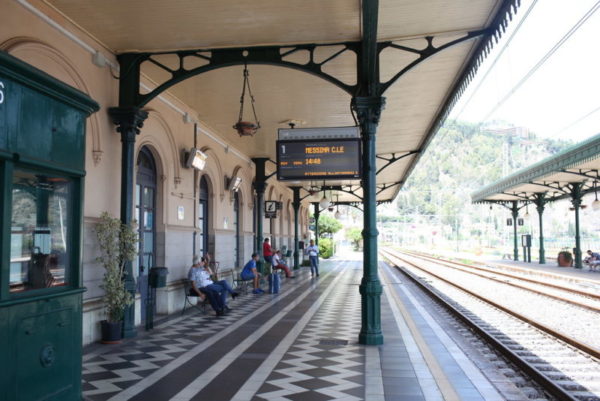Exploring the Beauty and History of Taormina-Giardini Train Station in Sicily

Taormina Giardini Train Station
This impressive building boasts a striking neo-Gothic style with a central body elevated to two floors, flanked by two elongated side bodies. The exterior facade is adorned with two symmetrically placed crenellated towers on either side of the central body. The entrance is protected by an artistic iron canopy. The design draws inspiration from the architectural motifs of the demolished Castello di Villagonia. The arch and pointed-arch windows are reminiscent of medieval Catalan-Sicilian Gothic architecture.
Address: Via Nazionale, 43, Villagonia ME, Italia Phone:
History
The interior of the station is beautifully furnished with dark wood furniture in the Sicilian style of the late 1800s. The walls and ceilings of the station’s rooms are adorned with frescoes and relief decorations by the Palermitan artist Salvatore Gregorietti, who also created the stained glass and iron furnishings. One of the best things about this train station is its location. It is harmoniously set in the surrounding landscape, nestled at the foot of the Taormina rock, on a terrace overlooking the beautiful bay of Naxos. The railway station in Taormina-Giardini was built as part of a program initiated by the Vittorio Emanuele Company in Sicily to connect the northernmost tip of Sicily and the port of Messina to the productive areas on the eastern coast of the island. The station was constructed in the space between two tunnels in the area below the town of Taormina, next to the State Road 114, around one kilometer before the start of the town of Giardini, in the village of Villagonia. It was named after the nearest village, Giardini, but soon the name Taormina was added, as the building was located within the municipality of Taormina, despite being farther away.
Check availability in Taorminamore …
The station was inaugurated on December 12, 1866, along with the opening of the Messina-Giardini railway line of the Messina-Siracusa railway, whose second section was inaugurated the following year. On January 3, 1867, the station was connected to the Catania station. Due to the financial difficulties of the Vittorio Emanuele Company in the mid-1970s, the management of the facilities was temporarily handed over to the Italian Company for the Southern Railways until 1885, when, following the division of the Italian railways into three major networks, it was taken over by the Sicilian Railway Company as part of the Sicilian Network. In 1905, it was finally purchased, along with the line, by the newly-formed State Railways. In the mid-1920s, the State Railways embarked on a program of railway infrastructure improvement, and among these was the station, which was completely rebuilt. The task of preparing the project was entrusted to the architect Roberto Narducci. The expansion works of the station, still a simple doubling, also included the expropriation of the Villagonia Castle, home of the noble San Martino family, princes of Pardo, dukes of Montalbano and Santo Stefano di Briga, which stood on the seaside in the area partly used for the construction of the new railway station. Together with the castle, the chapel of the Madonna of Porto Salvo was also demolished. The building was built between 1926 and 1928, the year in which the station was inaugurated and took its final name of Taormina-Giardini.
Video
Updated on: 29/01/2023 18:22:27